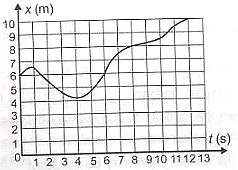A person travels along a straight road for the first time with a speed v1 and for next time with a speed v2. Then the mean speed v is given by
(1)
(2)
(3)
(4)
The figure shows the graph of the x-coordinate of a particle moving along the x-axis as a function of time. Average velocity during t=0 to 6 s and instantaneous velocity at t=3 s respectively, will be:
1. 10 m/s, 0
2. 60 m/s, 0
3. 0, 0
4. 0, 10 m/s
Position-time graph for a particle is shown in the figure. Starting from t=0, at what time t, the average velocity is zero?

(1) 1 s
(2) 3 s
(3) 6 s
(4) 7 s
| 1. | zero velocity. | 2. | zero acceleration. |
| 3. | non-zero velocity. | 4. | non-zero acceleration. |
If a particle is moving along a straight line with increasing speed, then:
| 1. | its acceleration is negative. |
| 2. | its acceleration may be decreasing. |
| 3. | its acceleration is positive. |
| 4. | both (2) & (3) |
At any instant, the velocity and acceleration of a particle moving along a straight line are v and a. The speed of the particle is increasing if
(1) v>0, a>0
(2) v<0, a>0
(3) v>0, a<0
(4) v>0, a=0
If the magnitude of average speed and average velocity over a time interval are the same, then
(1) The particle must move with zero acceleration
(2) The particle must move with non-zero acceleration
(3) The particle must be at rest
(4) The particle must move in a straight line without turning back
If v is the velocity of a body moving along x-axis, then acceleration of body is
(1)
(2)
(3)
(4)
If a body is moving with constant speed, then its acceleration
1. Must be zero
2. May be variable
3. May be uniform
4. Both (2) & (3)
When the velocity of a body is variable, then:
| 1. | its speed may be constant |
| 2. | its acceleration may be constant |
| 3. | its average acceleration may be constant |
| 4. | all of the above |







